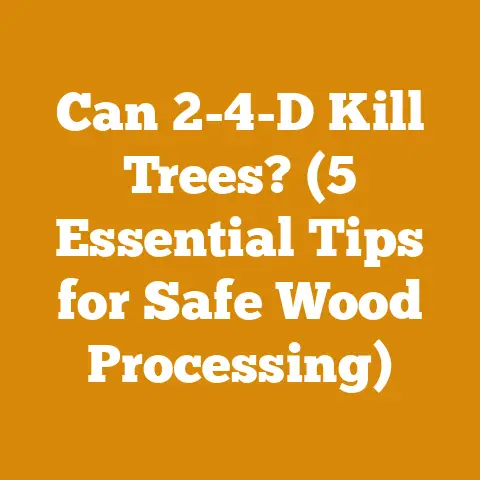How to Make Fire Starters Without Wax (5 Pro Wood Hacks)
Introduction: From Frustration to Fire – My Journey with DIY Fire Starters and the Metrics That Matter
I remember the frustration vividly. Damp wood, a stubborn flame, and a lighter that was running on fumes. I was camping, supposed to be enjoying nature, but instead, I was battling the elements, all because I hadn’t prepared decent fire starters. That night, huddled miserably around a pathetic excuse for a fire, I vowed to never be caught unprepared again.
That experience sparked my exploration into DIY fire starters – specifically, those that don’t rely on wax. I experimented with countless methods, from cotton balls and petroleum jelly to various wood shavings and natural resins. Some were successful, others were complete flops. But the real turning point came when I started treating these experiments like projects, tracking key metrics to understand why some worked and others didn’t.
This wasn’t just about making fire starters; it was about applying a systematic approach to a seemingly simple task. It taught me the value of meticulous preparation, the importance of understanding materials, and the power of data-driven decision-making.
This article shares what I’ve learned, focusing on five wax-free fire starter techniques and the project metrics I use to evaluate their effectiveness. These aren’t just recipes; they’re mini-projects, and understanding the metrics is crucial for maximizing your success, whether you’re a weekend camper, a small-scale logger, or a firewood supplier.
Why Track Metrics in Fire Starter Projects?
You might be thinking, “Metrics for fire starters? Isn’t that overkill?” Trust me, it’s not. Tracking metrics helps you:
- Optimize your materials: Learn which materials are most effective, readily available, and cost-efficient.
- Improve your process: Refine your techniques to create fire starters that light easily and burn reliably.
- Reduce waste: Minimize material waste by understanding the optimal proportions and construction methods.
- Enhance safety: Identify potential hazards and improve your fire-starting practices.
- Save time and money: Ultimately, knowing what works best saves you both time and money in the long run.
So, let’s dive into the five pro wood hacks for making fire starters without wax and the metrics I use to track their performance.
-
The Fatwood Fire Starter: Nature’s Gift
-
Definition: Fatwood is resin-impregnated heartwood found in pine trees, typically from the stump or dead branches. It’s naturally flammable due to its high resin content.
- Why it’s Important: Fatwood is an excellent natural fire starter. It lights easily, burns hot, and can even ignite in damp conditions.
- How to Interpret It: The key is to identify fatwood correctly and process it efficiently. Look for wood that is hard, dense, and smells strongly of pine resin.
- How it Relates to Other Metrics: The availability of fatwood directly impacts the cost and sustainability of this fire starter method.
Project Metrics for Fatwood Fire Starters:
-
Fatwood Sourcing Time (FST):
- Definition: The time it takes to locate and harvest a usable quantity of fatwood.
- Why it’s Important: This metric determines the feasibility of relying on fatwood as a primary fire starter source. Time is money, especially for commercial firewood operations.
- How to Interpret It: A high FST makes fatwood less attractive compared to other readily available options. An FST of less than 30 minutes per kilogram is generally considered efficient.
- How it Relates to Other Metrics: FST directly impacts the Cost per Fire Starter (CFS). If it takes hours to find a small amount of fatwood, the CFS will be prohibitively high. It also relates to Sustainability Index (SI), as overharvesting can deplete fatwood resources.
- Example: On one project, I spent 4 hours scouring a forest for fatwood, yielding only 500 grams. My FST was 8 hours per kilogram, making it an unsustainable option for regular use. Conversely, in another area, I found abundant fatwood in a fallen tree stump, harvesting 2 kilograms in 30 minutes. This gave me an FST of 15 minutes per kilogram, making it a viable choice.
- Actionable Insight: If your FST is high, consider exploring alternative fatwood sources or other fire starter methods. Consider if you have access to a sawmill or logging operation, as they may have fatwood available as a byproduct.
-
Fatwood Ignition Success Rate (FISR):
- Definition: The percentage of fatwood shavings or sticks that successfully ignite with a single match or lighter strike.
- Why it’s Important: A high FISR indicates the quality of the fatwood and the effectiveness of your preparation technique.
- How to Interpret It: An FISR below 80% suggests the fatwood may be damp, of poor quality, or not properly prepared.
- How it Relates to Other Metrics: FISR is linked to Moisture Content (MC). Higher MC results in lower FISR. It also influences the Burn Time (BT), as damp fatwood will burn less intensely and for a shorter duration.
- Example: I tested two batches of fatwood. Batch A, stored indoors, had an FISR of 95%. Batch B, left exposed to the elements, had an FISR of only 60%. This highlighted the importance of proper storage.
- Actionable Insight: Store fatwood in a dry, airtight container to maintain a high FISR. If the FISR is low, try drying the fatwood in a warm place before use.
-
Fatwood Burn Time (BT):
- Definition: The duration for which a given amount of fatwood burns with a usable flame.
- Why it’s Important: A longer BT provides more time to ignite larger pieces of wood, increasing the chances of a successful fire.
- How to Interpret It: A BT of at least 5 minutes is generally desirable. Shorter BTs may require more fatwood to start a fire.
- How it Relates to Other Metrics: BT is influenced by the Resin Content (RC) of the fatwood. Higher RC leads to longer BT. It also affects the Kindling Requirement (KR), as a longer BT reduces the need for excessive kindling.
- Example: I compared the BT of fatwood from two different pine species. Species A had a BT of 7 minutes, while Species B had a BT of only 3 minutes. This indicated that Species A had a higher resin content.
- Actionable Insight: Choose fatwood from pine species known for their high resin content. Experiment with different sizes and shapes of fatwood pieces to optimize BT.
-
Fatwood Cost per Fire Starter (CFS):
- Definition: The total cost associated with producing a single fatwood fire starter, including the cost of sourcing, processing, and packaging (if applicable).
- Why it’s Important: This metric helps determine the economic viability of using fatwood as a fire starter, especially for commercial purposes.
- How to Interpret It: A low CFS is essential for profitability. If the CFS is too high, consider alternative fire starter methods or optimizing your fatwood sourcing and processing techniques.
- How it Relates to Other Metrics: CFS is directly related to Fatwood Sourcing Time (FST) and Processing Time (PT). Reducing these times will lower the CFS.
- Example: If your FST is high, the CFS will be correspondingly high. If you can source fatwood for free and process it quickly, the CFS will be significantly lower.
- Actionable Insight: Track all costs associated with fatwood fire starter production, including labor, transportation, and packaging. Identify areas where you can reduce costs without compromising quality.
-
Fatwood Sustainability Index (SI):
- Definition: A measure of the environmental impact of harvesting fatwood, considering factors such as forest health, biodiversity, and responsible sourcing practices.
- Why it’s Important: Sustainable harvesting ensures the long-term availability of fatwood and minimizes environmental damage.
- How to Interpret It: A high SI indicates responsible and sustainable harvesting practices. A low SI suggests that harvesting is unsustainable and may harm the environment.
- How it Relates to Other Metrics: SI is influenced by Harvesting Location (HL) and Harvesting Method (HM). Harvesting fatwood from dead trees and fallen branches is more sustainable than harvesting from live trees.
- Example: Harvesting fatwood from a protected forest area would result in a low SI. Harvesting fatwood from a sustainably managed forest would result in a high SI.
- Actionable Insight: Always obtain permission before harvesting fatwood. Prioritize harvesting from dead trees and fallen branches. Support sustainable forestry practices.
-
The Birch Bark Torch: Nature’s Tinderbox
-
Definition: Birch bark, especially the outer layers, contains oils that make it highly flammable, even when slightly damp.
- Why it’s Important: Birch bark is a readily available and renewable resource in many regions, providing an excellent natural tinder.
- How to Interpret It: Look for thin, papery layers of bark that peel easily from dead or fallen birch trees. Avoid stripping bark from live trees, as this can harm them.
- How it Relates to Other Metrics: The dryness and oil content of the birch bark directly impact its Ignition Success Rate (ISR) and Burn Time (BT).
Project Metrics for Birch Bark Torches:
-
Birch Bark Collection Time (BBCT):
- Definition: The time required to collect a sufficient quantity of dry, usable birch bark.
- Why it’s Important: Determines the practicality of birch bark as a regular fire starter source.
- How to Interpret It: A lower BBCT is more desirable. Consider the accessibility of birch trees in your area.
- How it Relates to Other Metrics: Affects the Cost per Fire Starter (CFS). Time spent collecting bark translates to labor costs. Also related to Sustainability Index (SI), as over-stripping bark can harm birch trees.
- Example: I collected 500g of birch bark in 1 hour from fallen branches. My BBCT was 2 hours per kilogram. In another location with abundant dead birch trees, I collected the same amount in 30 minutes, reducing my BBCT to 1 hour per kilogram.
- Actionable Insight: Identify areas with abundant fallen birch trees or branches to reduce BBCT. Avoid stripping bark from live trees.
-
Birch Bark Ignition Success Rate (BBISR):
- Definition: The percentage of birch bark samples that successfully ignite with a single match or lighter strike.
- Why it’s Important: Indicates the quality of the bark and its suitability as a fire starter.
- How to Interpret It: Aim for a BBISR of 90% or higher. Lower rates suggest the bark is too damp or of poor quality.
- How it Relates to Other Metrics: Directly influenced by Moisture Content (MC). Higher MC reduces BBISR. Also affects Burn Time (BT).
- Example: Birch bark stored indoors had a BBISR of 95%. Bark collected from a damp forest floor had a BBISR of only 60%.
- Actionable Insight: Store birch bark in a dry, airtight container. Dry damp bark thoroughly before use.
-
Birch Bark Burn Time (BBBT):
- Definition: The duration a given amount of birch bark burns with a usable flame.
- Why it’s Important: A longer BBBT provides more time to ignite kindling.
- How to Interpret It: A BBBT of at least 3 minutes is generally sufficient.
- How it Relates to Other Metrics: Affected by the Oil Content (OC) of the bark. Higher OC leads to longer BBBT. Also influences the Kindling Requirement (KR).
- Example: I tested bark from different parts of the birch tree. Bark from the outer layers had a BBBT of 5 minutes, while bark from the inner layers had a BBBT of only 2 minutes.
- Actionable Insight: Prioritize collecting bark from the outer layers of the birch tree, as it contains more oil.
-
Birch Bark Preparation Time (BBPT):
- Definition: The time required to prepare the birch bark for use as a fire starter (e.g., shredding, rolling, or creating a torch).
- Why it’s Important: Impacts the overall efficiency of using birch bark fire starters.
- How to Interpret It: A lower BBPT is desirable.
- How it Relates to Other Metrics: Affects the Cost per Fire Starter (CFS). Time spent preparing bark translates to labor costs.
- Example: Shredding bark by hand took 10 minutes per 100g. Using a knife to curl the bark into rolls took only 5 minutes per 100g.
- Actionable Insight: Experiment with different preparation techniques to minimize BBPT. Consider using simple tools to speed up the process.
-
Birch Bark Sustainability Index (SI):
- Definition: A measure of the environmental impact of collecting birch bark, considering the health of the birch trees and the surrounding ecosystem.
- Why it’s Important: Ensures the long-term availability of birch bark and minimizes environmental damage.
- How to Interpret It: A high SI indicates responsible and sustainable harvesting practices.
- How it Relates to Other Metrics: Influenced by Collection Location (CL) and Collection Method (CM). Collecting bark from fallen trees is more sustainable than stripping bark from live trees.
- Example: Stripping bark from live birch trees in a protected forest area would result in a low SI. Collecting bark from fallen branches in a sustainably managed forest would result in a high SI.
- Actionable Insight: Always collect birch bark from fallen trees or branches. Avoid stripping bark from live trees.
-
The Pine Needle Nest: A Fragrant Flame
-
Definition: Dry pine needles, when bundled together, create a highly flammable nest that ignites easily and provides a sustained flame.
- Why it’s Important: Pine needles are abundant and readily available in many regions, making them a cost-effective fire starter option.
- How to Interpret It: Look for dry, brown pine needles that are brittle and easily crushed. Green pine needles are too moist to be effective.
- How it Relates to Other Metrics: The dryness and density of the pine needle nest directly impact its Ignition Success Rate (ISR) and Burn Time (BT).
Project Metrics for Pine Needle Nests:
-
Pine Needle Collection Time (PNCT):
- Definition: The time taken to gather a sufficient quantity of dry pine needles.
- Why it’s Important: Determines the practicality of using pine needles as a primary fire starter.
- How to Interpret It: A lower PNCT is preferable. Consider the accessibility of pine forests in your area.
- How it Relates to Other Metrics: Affects the Cost per Fire Starter (CFS). Time spent collecting needles translates to labor costs.
- Example: Collecting pine needles from a backyard took 15 minutes. Collecting them from a dense forest floor took 45 minutes.
- Actionable Insight: Choose easily accessible areas with abundant dry pine needles to minimize PNCT.
-
Pine Needle Ignition Success Rate (PNISR):
- Definition: The percentage of pine needle nests that successfully ignite with a single match or lighter strike.
- Why it’s Important: Indicates the quality of the pine needles and the effectiveness of the nest construction.
- How to Interpret It: Aim for a PNISR of 85% or higher. Lower rates suggest the needles are too damp or the nest is not properly constructed.
- How it Relates to Other Metrics: Directly influenced by Moisture Content (MC) and Nest Density (ND). Higher MC and lower ND reduce PNISR.
- Example: A loosely packed nest of damp needles had a PNISR of 50%. A tightly packed nest of dry needles had a PNISR of 95%.
- Actionable Insight: Ensure the pine needles are completely dry before use. Construct a tightly packed nest to promote airflow and combustion.
-
Pine Needle Burn Time (PNBT):
- Definition: The duration a pine needle nest burns with a usable flame.
- Why it’s Important: A longer PNBT provides more time to ignite kindling.
- How to Interpret It: A PNBT of at least 2 minutes is generally sufficient.
- How it Relates to Other Metrics: Affected by Needle Size (NS) and Nest Density (ND). Longer needles and a denser nest lead to longer PNBT.
- Example: A nest made of short needles had a PNBT of 1 minute. A nest made of long needles had a PNBT of 3 minutes.
- Actionable Insight: Use longer pine needles whenever possible. Construct a dense nest to maximize burn time.
-
Pine Needle Nest Construction Time (PNNCT):
- Definition: The time required to construct a single pine needle nest.
- Why it’s Important: Impacts the overall efficiency of using pine needle fire starters.
- How to Interpret It: A lower PNNCT is desirable.
- How it Relates to Other Metrics: Affects the Cost per Fire Starter (CFS). Time spent constructing nests translates to labor costs.
- Example: Constructing a nest by hand took 3 minutes. Using a simple jig to form the nest took only 1 minute.
- Actionable Insight: Experiment with different construction techniques to minimize PNNCT. Consider using simple tools to speed up the process.
-
Pine Needle Availability Index (PNAI):
- Definition: A measure of the abundance and accessibility of dry pine needles in a given area.
- Why it’s Important: Determines the long-term feasibility of relying on pine needles as a fire starter source.
- How to Interpret It: A high PNAI indicates a readily available and sustainable source of pine needles.
- How it Relates to Other Metrics: Influences the Pine Needle Collection Time (PNCT) and the Cost per Fire Starter (CFS).
- Example: An area with a dense pine forest and a dry climate would have a high PNAI. An area with sparse pine trees and a humid climate would have a low PNAI.
- Actionable Insight: Assess the availability of pine needles in your area before relying on them as a primary fire starter source.
-
The Cottonwood Fluff Ball: Nature’s Cotton
-
Definition: Cottonwood fluff, the seed-bearing material released by cottonwood trees, is incredibly flammable when dry.
- Why it’s Important: Cottonwood fluff is a readily available and renewable resource in many regions, providing an excellent natural tinder.
- How to Interpret It: Collect the fluff when it is dry and easily detached from the cottonwood trees.
- How it Relates to Other Metrics: The dryness and purity of the cottonwood fluff directly impact its Ignition Success Rate (ISR) and Burn Time (BT).
Project Metrics for Cottonwood Fluff Balls:
-
Cottonwood Fluff Collection Time (CFCT):
- Definition: The time required to collect a sufficient quantity of dry cottonwood fluff.
- Why it’s Important: Determines the practicality of using cottonwood fluff as a regular fire starter.
- How to Interpret It: A lower CFCT is more desirable. Consider the accessibility of cottonwood trees in your area.
- How it Relates to Other Metrics: Affects the Cost per Fire Starter (CFS). Time spent collecting fluff translates to labor costs.
- Example: I collected 100g of cottonwood fluff in 30 minutes from trees in a nearby park. My CFCT was 5 hours per kilogram.
- Actionable Insight: Choose easily accessible areas with abundant cottonwood trees to minimize CFCT.
-
Cottonwood Fluff Ignition Success Rate (CFISR):
- Definition: The percentage of cottonwood fluff balls that successfully ignite with a single match or lighter strike.
- Why it’s Important: Indicates the quality of the fluff and its suitability as a fire starter.
- How to Interpret It: Aim for a CFISR of 95% or higher. Lower rates suggest the fluff is too damp or contains too much debris.
- How it Relates to Other Metrics: Directly influenced by Moisture Content (MC) and Purity (P). Higher MC and lower P reduce CFISR.
- Example: Cottonwood fluff stored indoors had a CFISR of 98%. Fluff collected after a rainstorm had a CFISR of only 40%.
- Actionable Insight: Collect cottonwood fluff on dry days. Store it in a dry, airtight container. Remove any debris before use.
-
Cottonwood Fluff Burn Time (CFBT):
- Definition: The duration a cottonwood fluff ball burns with a usable flame.
- Why it’s Important: A longer CFBT provides more time to ignite kindling.
- How to Interpret It: A CFBT of at least 1 minute is generally sufficient.
- How it Relates to Other Metrics: Affected by Fluff Density (FD) and Ball Size (BS). A denser fluff ball and a larger size lead to longer CFBT.
- Example: A loosely packed fluff ball had a CFBT of 30 seconds. A tightly packed fluff ball had a CFBT of 1 minute and 30 seconds.
- Actionable Insight: Pack the cottonwood fluff tightly when forming the ball. Experiment with different ball sizes to optimize burn time.
-
Cottonwood Fluff Preparation Time (CFPT):
- Definition: The time required to prepare the cottonwood fluff for use as a fire starter (e.g., forming it into a ball).
- Why it’s Important: Impacts the overall efficiency of using cottonwood fluff fire starters.
- How to Interpret It: A lower CFPT is desirable.
- How it Relates to Other Metrics: Affects the Cost per Fire Starter (CFS). Time spent preparing fluff translates to labor costs.
- Example: Forming a fluff ball by hand took 1 minute. Using a simple mold to form the ball took only 30 seconds.
- Actionable Insight: Experiment with different preparation techniques to minimize CFPT. Consider using simple tools to speed up the process.
-
Cottonwood Fluff Collection Seasonality (CFCS):
- Definition: The limited time window during which cottonwood fluff is available for collection.
- Why it’s Important: Determines the long-term reliability of cottonwood fluff as a fire starter source.
- How to Interpret It: A short CFCS requires planning and efficient collection during the available period.
- How it Relates to Other Metrics: Influences the Cottonwood Fluff Collection Time (CFCT) and the Cost per Fire Starter (CFS).
- Example: Cottonwood fluff is typically available for only 2-3 weeks in the spring.
- Actionable Insight: Plan your cottonwood fluff collection activities during the peak season. Collect a sufficient quantity to last throughout the year.
-
The Shaved Wood Fire Starter: A Crafty Solution
-
Definition: Thin shavings of dry wood, especially softwood like pine or cedar, ignite easily and provide a sustained flame.
- Why it’s Important: Shaved wood is a readily available resource, particularly for those who work with wood.
- How to Interpret It: The key is to create thin, feather-like shavings that have a large surface area for easy ignition.
- How it Relates to Other Metrics: The dryness and type of wood directly impact its Ignition Success Rate (ISR) and Burn Time (BT).
Project Metrics for Shaved Wood Fire Starters:
-
Wood Shaving Production Time (WSPT):
- Definition: The time required to produce a sufficient quantity of dry wood shavings.
- Why it’s Important: Determines the practicality of using wood shavings as a regular fire starter.
- How to Interpret It: A lower WSPT is more desirable. Consider the availability of dry wood and efficient shaving tools.
- How it Relates to Other Metrics: Affects the Cost per Fire Starter (CFS). Time spent producing shavings translates to labor costs.
- Example: Shaving wood with a knife took 15 minutes per 100g. Using a drawknife took only 5 minutes per 100g.
- Actionable Insight: Experiment with different shaving tools and techniques to minimize WSPT.
-
Wood Shaving Ignition Success Rate (WSISR):
- Definition: The percentage of wood shaving piles that successfully ignite with a single match or lighter strike.
- Why it’s Important: Indicates the quality of the shavings and their suitability as a fire starter.
- How to Interpret It: Aim for a WSISR of 90% or higher. Lower rates suggest the shavings are too damp or not thin enough.
- How it Relates to Other Metrics: Directly influenced by Moisture Content (MC) and Shaving Thickness (ST). Higher MC and thicker ST reduce WSISR.
- Example: Shavings made from kiln-dried wood had a WSISR of 95%. Shavings made from freshly cut wood had a WSISR of only 60%.
- Actionable Insight: Use dry wood for shaving. Create thin, feather-like shavings to maximize surface area.
-
Wood Shaving Burn Time (WSBT):
- Definition: The duration a pile of wood shavings burns with a usable flame.
- Why it’s Important: A longer WSBT provides more time to ignite kindling.
- How to Interpret It: A WSBT of at least 2 minutes is generally sufficient.
- How it Relates to Other Metrics: Affected by Wood Type (WT) and Shaving Volume (SV). Softwoods with high resin content and a larger volume of shavings lead to longer WSBT.
- Example: Pine shavings had a WSBT of 3 minutes. Oak shavings had a WSBT of only 1 minute.
- Actionable Insight: Use softwood species like pine or cedar for shaving. Create a generous pile of shavings to maximize burn time.
-
Wood Shaving Storage Requirements (WSSR):
- Definition: The space and conditions required to store wood shavings properly.
- Why it’s Important: Proper storage prevents moisture absorption and ensures the shavings remain flammable.
- How to Interpret It: A lower WSSR is more convenient.
- How it Relates to Other Metrics: Affects the Wood Shaving Ignition Success Rate (WSISR). Improper storage can increase moisture content and reduce WSISR.
- Example: Storing shavings in an airtight container in a dry location minimized moisture absorption.
- Actionable Insight: Store wood shavings in a dry, airtight container to maintain their flammability.
-
Wood Waste Utilization Rate (WWUR):
- Definition: The percentage of wood waste (e.g., scraps, offcuts) that is converted into wood shavings for fire starters.
- Why it’s Important: Promotes efficient resource utilization and reduces waste.
- How to Interpret It: A higher WWUR is desirable.
- How it Relates to Other Metrics: Influences the Cost per Fire Starter (CFS) and the Environmental Impact (EI). Utilizing wood waste reduces the need to purchase new materials and minimizes landfill waste.
- Example: Converting 50% of wood scraps into shavings resulted in a significant reduction in waste disposal costs.
- Actionable Insight: Integrate wood shaving production into your wood processing workflow to utilize wood waste effectively.
Applying These Metrics to Improve Future Projects
The beauty of tracking these metrics is that it allows you to continuously improve your fire starter projects. Here’s how:
- Analyze Your Data: Review the data you’ve collected for each fire starter method. Identify areas where you can improve efficiency, reduce costs, or enhance performance.
- Experiment and Iterate: Use the insights gained from your data to experiment with different materials, techniques, and tools. Track the results of these experiments and iterate on your process.
- Document Your Findings: Keep a detailed record of your projects, including the metrics you tracked, the materials you used, and the results you achieved. This documentation will serve as a valuable resource for future projects.
- Share Your Knowledge: Share your experiences and insights with others in the wood processing and firewood preparation community. By sharing your knowledge, you can help others improve their projects and contribute to a more sustainable and efficient industry.
By embracing a data-driven approach to fire starter projects, you can transform a simple task into a valuable learning experience. You’ll not only create reliable fire starters but also develop a deeper understanding of wood, materials, and the principles of project management. So, grab your tools, gather your materials, and start tracking those metrics. Your next campfire will be your best yet!






